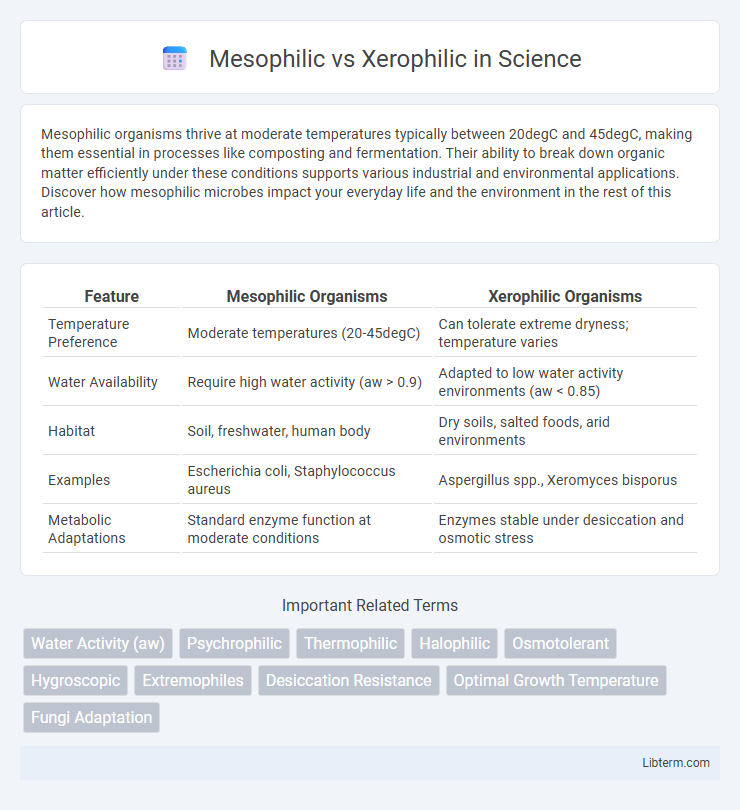Mesophilic organisms thrive at moderate temperatures typically between 20degC and 45degC, making them essential in processes like composting and fermentation. Their ability to break down organic matter efficiently under these conditions supports various industrial and environmental applications. Discover how mesophilic microbes impact your everyday life and the environment in the rest of this article.
Table of Comparison
| Feature | Mesophilic Organisms | Xerophilic Organisms |
|---|---|---|
| Temperature Preference | Moderate temperatures (20-45degC) | Can tolerate extreme dryness; temperature varies |
| Water Availability | Require high water activity (aw > 0.9) | Adapted to low water activity environments (aw < 0.85) |
| Habitat | Soil, freshwater, human body | Dry soils, salted foods, arid environments |
| Examples | Escherichia coli, Staphylococcus aureus | Aspergillus spp., Xeromyces bisporus |
| Metabolic Adaptations | Standard enzyme function at moderate conditions | Enzymes stable under desiccation and osmotic stress |
Understanding Mesophilic and Xerophilic Organisms
Mesophilic organisms thrive in moderate temperature ranges typically between 20degC and 45degC, commonly found in soil, water, and the human body, playing crucial roles in decomposition and fermentation processes. Xerophilic organisms, on the other hand, adapt to extremely dry environments by surviving with minimal water activity, often colonizing deserts, dried foods, and salted or sugared substrates. Understanding the physiological adaptations of mesophiles and xerophiles is essential for applications in biotechnology, food preservation, and environmental microbiology.
Key Differences Between Mesophilic and Xerophilic Microbes
Mesophilic microbes thrive at moderate temperatures ranging from 20degC to 45degC, while xerophilic microbes adapt to extremely dry environments with minimal water availability. Mesophiles require a balanced moisture level for growth, whereas xerophiles possess specialized mechanisms to survive and metabolize under low water activity conditions. The key difference lies in their ecological niches: mesophiles dominate in moist, temperate habitats, whereas xerophiles excel in arid, desiccated ecosystems.
Optimal Growth Conditions for Mesophiles
Mesophiles thrive in moderate temperature ranges, typically between 20degC and 45degC, with an optimum around 37degC, making them well-suited for environments like the human body and soil. These organisms require moderate moisture levels and neutral pH for optimal growth, contrasting with xerophiles that tolerate extremely dry and low-moisture conditions. Understanding mesophilic growth parameters is crucial for applications in biotechnology, food safety, and medical microbiology.
Environmental Adaptations of Xerophilic Species
Xerophilic species thrive in environments with extremely low water availability by developing specialized adaptations such as thick cell walls, efficient water retention mechanisms, and production of protective extracellular polymers to minimize desiccation. These organisms often accumulate compatible solutes like trehalose and glycerol to stabilize proteins and cellular structures under osmotic stress. Unlike mesophilic species that prefer moderate moisture and temperature, xerophiles dominate arid habitats including deserts, dried foods, and hypersaline conditions, showcasing remarkable survival strategies in extreme dryness.
Industrial Applications of Mesophilic Organisms
Mesophilic organisms thrive at moderate temperatures, typically between 20degC and 45degC, making them ideal for industrial applications such as wastewater treatment, biofuel production, and fermentation processes. Their ability to efficiently break down organic matter under mesophilic conditions enhances biogas yield and stabilizes sludge, reducing operational costs in anaerobic digesters. Mesophilic microbes are also widely used in the food industry for producing dairy products, antibiotics, and enzymes due to their stable metabolism at ambient temperatures.
Food Preservation and Xerophilic Microbes
Mesophilic microbes thrive at moderate temperatures between 20degC and 45degC, playing a significant role in conventional food fermentation processes but often contributing to spoilage in perishable foods. Xerophilic microbes, on the other hand, survive and grow in low-water-activity environments, enabling the preservation of dried and high-sugar foods by inhibiting spoilage through moisture limitation. The application of xerophilic fungi and yeasts in food preservation enhances shelf life by preventing microbial degradation, particularly in dehydrated products like dried fruits, jerky, and sweets.
Comparative Physiology: Mesophiles vs Xerophiles
Mesophiles thrive at moderate temperatures between 20degC and 45degC, exhibiting optimal enzymatic activity and membrane fluidity suited for these conditions, while xerophiles are adapted to extremely dry environments with cellular mechanisms that prevent desiccation by accumulating compatible solutes and modifying membrane lipids to retain water. Mesophiles display metabolic pathways optimized for stable hydration and nutrient availability, whereas xerophiles possess unique stress response systems enabling survival under osmotic pressure and oxidative stress caused by low water activity. Differences in gene expression between these organisms reveal distinct regulatory networks for protein stabilization, DNA repair, and osmoprotectant synthesis reflective of their environmental specializations.
Role in Spoilage: Mesophilic and Xerophilic Fungi
Mesophilic fungi thrive at moderate temperatures, significantly contributing to spoilage in food stored at room temperature by decomposing carbohydrates and proteins. Xerophilic fungi tolerate low water activity, enabling them to spoil dried and low-moisture products such as grains, nuts, and dried fruits by producing mycotoxins and causing discoloration. Both types pose challenges in food preservation due to their distinct environmental adaptations and spoilage mechanisms.
Detection and Control of Mesophilic and Xerophilic Contaminants
Detection of mesophilic contaminants relies on incubation at moderate temperatures (20-45degC) using selective agar media to identify bacteria and fungi that thrive in these conditions. Xerophilic contaminants, adapted to low water activity environments, require specialized detection methods involving low-moisture media and extended incubation times to recover fungi and bacteria capable of growth in high solute concentrations. Control strategies include maintaining proper temperature regulation and moisture levels to inhibit mesophilic microbial growth, while reducing water activity through drying, adding preservatives, or packaging that limits moisture is critical to prevent xerophilic contaminant proliferation.
Future Research Directions in Mesophilic and Xerophilic Studies
Future research in mesophilic and xerophilic studies is poised to explore genetic adaptations that enable survival under moderate and extremely dry conditions, respectively. Advances in metagenomics and proteomics will enhance understanding of microbial community dynamics and stress response mechanisms in varying environments. Emerging biotechnological applications aim to exploit mesophilic and xerophilic organisms for sustainable agriculture, bioremediation, and industrial processes under climate change pressures.
Mesophilic Infographic

 libterm.com
libterm.com